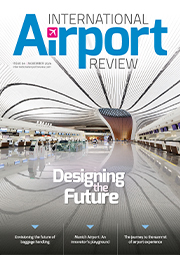How the air transport industry is planning for the future
- Like
- Digg
- Del
- Tumblr
- VKontakte
- Buffer
- Love This
- Odnoklassniki
- Meneame
- Blogger
- Amazon
- Yahoo Mail
- Gmail
- AOL
- Newsvine
- HackerNews
- Evernote
- MySpace
- Mail.ru
- Viadeo
- Line
- Comments
- Yummly
- SMS
- Viber
- Telegram
- Subscribe
- Skype
- Facebook Messenger
- Kakao
- LiveJournal
- Yammer
- Edgar
- Fintel
- Mix
- Instapaper
- Copy Link
Posted: 24 May 2016 | Nick Careen (IATA) | No comments yet
With air travel expected to reach seven billion passengers by 2034, Nick Careen, IATA’s Senior Vice President for Airport, Passenger, Cargo and Security, reveals how the air transport industry is planning for the future…


After what has sometimes felt like a decade of crisis, the airline industry appears to be entering a period of relative calm and prosperity. Growth, which barely paused even during the global financial crisis, is roaring ahead with passenger journeys exceeding two billion for the first time in 2005, surpassed by 3.5 billion last year, and set to reach seven billion in 2034.
The industry has not been complacent during this period of growth. On the contrary, the high cost of oil that persisted during the decade from 2005 forced airlines to dramatically improve their efficiency. Today airlines are leaner, greener, and much more customer focused than ever before.
But success brings its own challenges. Rapidly increasing numbers of passengers and flights are creating great pressure on aviation infrastructure, threatening the ability of the industry to meet future demand to fly. I’d like to highlight just three of the programmes IATA and the industry are working on to tackle this challenge: transforming the passenger experience through Fast Travel; re-purposing the traditional airport checkpoint with Smart Security; and in the cargo sphere, cutting losses and improving customer service through transformation of processes and technology.
With many airports reaching the limits of their physical footprint, radical solutions need to be found if we are to avoid gridlock as well as meet enhanced expectations for quality of service. Fortunately, more efficient use of our infrastructure and an improved passenger experience are two sides of the same coin. IATA’s vision is for a seamless kerb-to-airside experience where the passenger is given self-service control of their journey and experience the bare minimum of touchpoints where potential bottlenecks can form. One of the ways the industry is reaching this vision is through the Fast Travel programme. Fast Travel encompasses six elements: self-check-in, bags ready-to-go (including self- and electronic-tagging), document check, self-boarding, flight rebooking, and bag recovery. Surveys consistently show that passengers prefer to use these self-service options. They have an additional benefit in that they open up scarce airport infrastructure space that would otherwise require more check-in desks and baggage facilities. The industry target for Fast Travel implementation is for 80% of passengers to have access to all six elements by 2020. We are making progress but one of our biggest challenges is in the European Union, where passengers are still not permitted to use home printed bag tags. The situation is frustrating when so many other parts of the world are embracing the opportunities that new technology offers. But we continue to engage with the EU and I am hopeful that we will have a breakthrough soon.
Another area where we urgently need a new approach is the issue of airport security. As security threats have changed, the old airport security system that was conceived to catch hijackers in the 1970s has become increasingly inefficient and inconvenient for passengers. To face the new threats of today and tomorrow IATA and ACI, the trade association for the world’s airports, have partnered on the Smart Security programme. Through new technology and innovative processes, this aims to deliver an updated airport security system, flexible enough to cope with evolving requirements, yet efficient, effective, and providing a better experience for passengers. It is now for regulators to proactively embrace these innovations, including risk-based concepts, and drive towards global harmonisation of airport security measures.
Finally, it is vital not to forget how important air freight is to making the modern global village possible. Air cargo is experiencing a period of transformation as the needs of its customers change, with a renewed focus on quality and reliability. Digital transformation is a key element of that. Efforts to increase the adoption of paperless processes such as the e-AWB have moved slowly, although progress has been made. Additionally, projects such as CEIV Pharma, which gives shippers greater confidence in the reliability of time-and-temperature sensitive products, show that the industry is ready to respond to customer needs in order to reach new markets and give greater value.
I hope the brief snapshot I have given of just three of our current industry programmes reminds us that we must continue to review every aspect of our operations if we are to be ready for the challenges of the future. We can never stop pushing the boundaries of our vision – seven billion passengers will depend on it.
Biography
Currently IATA’s Senior Vice President for the Airport, Passenger, Cargo and Security Division, Nick Careen is responsible for IATA’s relations with airports, fuel supply, passenger experience, cargo, security and ground handling for IATA member airlines and industry partners around the world. Nick built his career in Air Canada and its subsidiary Jazz where his last role was as Air Canada Vice President for Airport, Call Centres and Customer Relations, a position he held from 2013 to 2014. He has a wealth of experience covering flight and airport operations, human resource management and government relations.
The rest of this article is restricted - login or subscribe free to access


Why subscribe? Join our growing community of thousands of industry professionals and gain access to:
- bi-monthly issues in print and/or digital format
- case studies, whitepapers, webinars and industry-leading content
- breaking news and features
- our extensive online archive of thousands of articles and years of past issues
- ...And it's all free!
Click here to Subscribe today Login here













